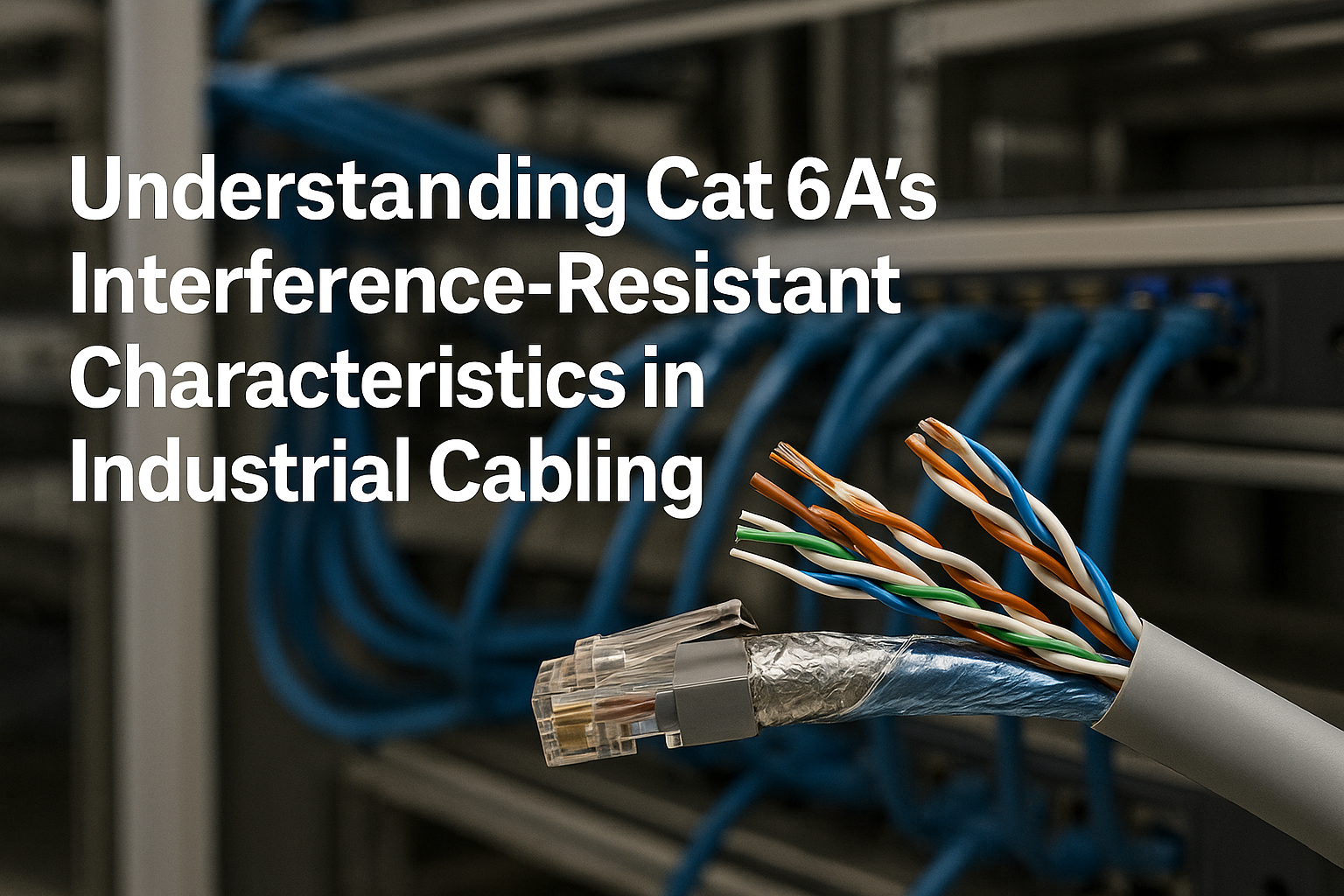
Cat 6A’s Interference-Resistant Characteristics in Industrial Cabling
In today’s increasingly connected industrial environments, the demand for high-speed, reliable data transmission has never been higher. From factory automation to smart grid systems, Ethernet cables form the backbone of modern industrial networks. Among the many types available, Category 6A (Cat 6A) cables stand out for their exceptional interference-resistant performance, making them a preferred choice for demanding industrial applications.
This article explores in detail the anti-interference features of Cat 6A cables and explains why they are essential in industrial cabling systems.
What is Cat 6A Cable?
Cat 6A, short for Category 6 Augmented, is an enhanced version of Cat 6 cable, supporting 10 Gigabit Ethernet (10GBASE-T) at frequencies up to 700 MHz—twice the bandwidth of Cat 5e. While Cat 6 can handle 10Gbps at distances up to 55 meters, Cat 6A can do so up to 100 meters, making it ideal for larger industrial installations.
But one of Cat 6A’s most compelling features in industrial environments is its robust shielding and interference mitigation capabilities.
Sources of Interference in Industrial Environments
Industrial settings pose unique challenges to data cabling due to:
l Electromagnetic interference (EMI) from heavy machinery
l Radio frequency interference (RFI) from wireless equipment
l Crosstalk from adjacent cables in densely packed cable trays
l Temperature fluctuations and physical abrasion
These factors can cause data loss, latency, and system downtime if the cabling infrastructure is not properly shielded or optimized.
 Cat 6A’s Shielding Design
Cat 6A’s Shielding Design
Cat 6A cables are designed to address these challenges with enhanced shielding technologies:
1. Individual Pair Shielding (FTP/STP):
Many Cat 6A cables use Foiled Twisted Pair (FTP) or Shielded Twisted Pair (STP) construction. Each pair of wires is wrapped in foil or a metallic shield, which helps to block external EMI/RFI and prevent alien crosstalk—a major concern in high-density industrial cable runs.
2. Overall Cable Shielding (S/FTP):
In some configurations, Cat 6A also includes an overall braided or foil shield over the entire cable. This double-layered protection ensures even higher interference immunity and improved signal integrity.
3. Tighter Twists and Isolation:
Compared to Cat 5e or Cat 6e, Cat 6A cables have tighter twisted pairs and often include internal separators to reduce internal crosstalk. This structural design minimizes noise and improves performance, especially over longer distances.
|
Cable Type |
Frequency (MHz) |
Shielding Type |
Interference Resistance (1-10) |
|
350 |
UTP |
4 |
|
|
600 |
UTP / FTP |
6 |
|
|
700 |
FTP / S/FTP |
9-10 |
Alien Crosstalk Protection
One of the biggest concerns in high-speed Ethernet transmission is alien crosstalk, where signals from one cable interfere with another. Cat 6A’s augmented shielding effectively reduces this phenomenon. This is particularly important in industrial environments where multiple cables are bundled or routed closely together in cable trays or conduits.
Consistent Performance in Harsh Conditions
Industrial applications often involve exposure to:
l High temperatures
l Moisture or humidity
l Chemicals
l Vibration and movement
Cat 6A cables are available in industrial-grade jackets such as PVC, LSZH (Low Smoke Zero Halogen), or even PUR for added resistance to abrasion, oils, and harsh environments. This ensures that the cable maintains its interference-resistant properties even under extreme conditions.
Benefits of Using Cat 6A in Industrial Cabling
1. Reduced Signal Interference:
Enhanced shielding keeps EMI and RFI at bay, ensuring more reliable data transmission.
2. Improved Data Integrity:
Less interference means fewer transmission errors, reduced latency, and better overall network performance.
3. Future-Proofing:
With support for 10Gbps speeds, Cat 6A ensures longevity as industrial systems demand higher data throughput.
4. Compliance with Industrial Standards:
SYSTON Cat 6A cables meet TIA-568.2-D and ISO/IEC 11801 Class EA standards for performance and interference control.
Applications of Cat 6A in Industrial Settings
l Factory automation systems
l Industrial control networks
l Surveillance and security systems
l Smart manufacturing (Industry 4.0)
l SCADA and PLC systems
In each of these applications, the noise immunity and signal stability offered by Cat 6A help maintain uninterrupted operations and system reliability.
Conclusion
As industries move toward higher automation and data-intensive operations, the importance of selecting the right Ethernet cable becomes critical. Cat 6A cables offer superior interference resistance, making them an ideal solution for high-performance, high-reliability industrial networks.
By investing in Cat 6A infrastructure, industrial businesses can achieve enhanced data integrity, reduced downtime, and better preparedness for future networking demands.
Got any problem? Contact our online customer service on our website or subscribe to our Facebook page. Our professional cable experts are at your service at any time.

Leave a comment